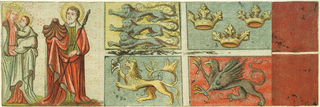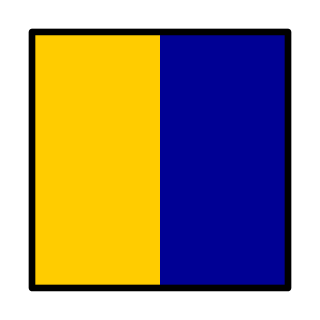
A flag is a piece of fabric with a distinctive design and colours. It is used as a symbol, a signalling device, or for decoration. The term flag is also used to refer to the graphic design employed, and flags have evolved into a general tool for rudimentary signalling and identification, especially in environments where communication is challenging. Many flags fall into groups of similar designs called flag families. The study of flags is known as "vexillology" from the Latin vexillum, meaning "flag" or "banner".

SOS is a Morse code distress signal, used internationally, originally established for maritime use. In formal notation SOS is written with an overscore line, to indicate that the Morse code equivalents for the individual letters of "SOS" are transmitted as an unbroken sequence of three dots / three dashes / three dots, with no spaces between the letters. In International Morse Code three dots form the letter "S" and three dashes make the letter "O", so "S O S" became a common way to remember the order of the dots and dashes.

An optical telegraph is a line of stations, typically towers, for the purpose of conveying textual information by means of visual signals. There are two main types of such systems; the semaphore telegraph which uses pivoted indicator arms and conveys information according to the direction the indicators point, and the shutter telegraph which uses panels that can be rotated to block or pass the light from the sky behind to convey information.

Captain Frederick Marryat was a Royal Navy officer, a novelist, and an acquaintance of Charles Dickens. He is noted today as an early pioneer of nautical fiction, particularly for his semi-autobiographical novel Mr Midshipman Easy (1836). He is remembered also for his children's novel The Children of the New Forest (1847), and for a widely used system of maritime flag signalling known as Marryat's Code.
A distress signal, also known as a distress call, is an internationally recognized means for obtaining help. Distress signals are communicated by transmitting radio signals, displaying a visually observable item or illumination, or making a sound audible from a distance.

A maritime flag is a flag designated for use on ships, boats, and other watercraft. Naval flags are considered important at sea and the rules and regulations for the flying of flags are strictly enforced. The flag flown is related to the country of registration: so much so that the word "flag" is often used symbolically as a metonym for "country of registration".

International maritime signal flags are various flags used to communicate with ships. The principal system of flags and associated codes is the International Code of Signals. Various navies have flag systems with additional flags and codes, and other flags are used in special uses, or have historical significance.

Rear Admiral Sir Home Riggs Popham, KCB, KCH, was a Royal Navy commander who saw service against the French during the Revolutionary and Napoleonic Wars. He is remembered for his scientific accomplishments, particularly the development of a signal code that was adopted by the Royal Navy in 1803.

The commissioning pennant is a pennant flown from the masthead of a warship. The history of flying a commissioning pennant dates back to the days of chivalry with their trail pendants being flown from the mastheads of ships they commanded. Today, the commissioning pennants are hoisted on the day of commissioning and not struck until they are decommissioned. Some navies have a custom of flying a "paying off" or "decommissioning pennant," the length of which often reflects the length of service of the warship.
A telegraph code is one of the character encodings used to transmit information by telegraphy. Morse code is the best-known such code. Telegraphy usually refers to the electrical telegraph, but telegraph systems using the optical telegraph were in use before that. A code consists of a number of code points, each corresponding to a letter of the alphabet, a numeral, or some other character. In codes intended for machines rather than humans, code points for control characters, such as carriage return, are required to control the operation of the mechanism. Each code point is made up of a number of elements arranged in a unique way for that character. There are usually two types of element, but more element types were employed in some codes not intended for machines. For instance, American Morse code had about five elements, rather than the two of International Morse Code.

"England expects that every man will do his duty" was a signal sent by Vice-Admiral of the Royal Navy Horatio Nelson, 1st Viscount Nelson from his flagship HMS Victory as the Battle of Trafalgar was about to commence on 21 October 1805.
Flag signals can mean any of various methods of using flags or pennants to send signals. Flags may have individual significance as signals, or two or more flags may be manipulated so that their relative positions convey symbols. Flag signals allowed communication at a distance before the invention of radio and are still used especially in connection with ships.

The International Code of Signals (INTERCO) is an international system of signals and codes for use by vessels to communicate important messages regarding safety of navigation and related matters. Signals can be sent by flaghoist, signal lamp ("blinker"), flag semaphore, radiotelegraphy, and radiotelephony. The International Code is the most recent evolution of a wide variety of maritime flag signalling systems.
The combination of the Bravo and Zulu nautical signal flags, i.e., Bravo Zulu, also referred to as "BZ," is a naval signal, typically conveyed by flaghoist or voice radio, meaning "Well Done" with regard to actions, operations or performance. In addition to the British Royal Navy, it has also been used as part of vernacular slang within the U.S. Navy, NATO, and other Allied naval forces. It can be combined with the "negative" signal, spoken or written as NEGAT, to say "NEGAT Bravo Zulu" to convey "not well done" for a given action.

Code letters or ship's call sign were a method of identifying ships before the introduction of modern navigation aids and today also. Later, with the introduction of radio, code letters were also used as radio call signs.
Naval flag signalling covers various forms of flag signalling, such as semaphore or flaghoist, used by various navies; distinguished from maritime flag signalling by merchant or other non-naval vessels or flags used for identification.

Semaphore is the use of an apparatus to create a visual signal transmitted over distance. A semaphore can be performed with devices including: fire, lights, flags, sunlight, and moving arms. Semaphores can be used for telegraphy when arranged in visually connected networks, or for traffic signalling such as in railway systems, or traffic lights in cities.

Maritime call signs are call signs assigned as unique identifiers to ships and boats. All radio transmissions must be individually identified by the call sign. Merchant and naval vessels are assigned call signs by their national licensing authorities.

A ship identifier refers to one of several types of identifiers used for maritime vessels. An identifier may be a proper noun ; a proper noun combined with a standardized prefix based on the type of ship ; a serial code; a unique, alphanumeric ID ; or an alphanumeric ID displayed in international signal flags. Some identifiers are permanent for a ship while others may be changed at the owners' discretion although regulatory agencies will need to approve the change. Modern ships will usually have several identifiers.

The Foy–Breguet telegraph, also called the French telegraph, was an electrical telegraph of the needle telegraph type developed by Louis-François-Clement Breguet and Alphonse Foy in the 1840s for use in France. The system used two-needle instruments that presented a display using the same code as that on the optical telegraph of Claude Chappe. The Chappe telegraph was extensively used in France by the government, so this arrangement was appealing to them as it meant there was no need to retrain operators.















